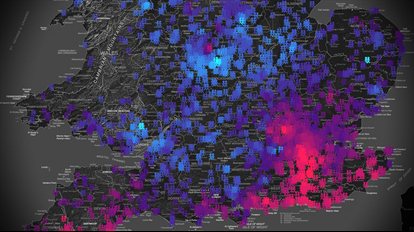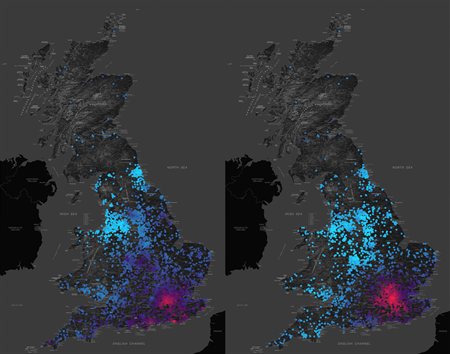Nature or nurture? It may depend on where you live
The extent to which our development is affected by nature or nurture – our genetic make-up or our environment – may differ depending on where we live, according to new research by King's College London's Institute of Psychiatry (IoP).
The study, funded by the Medical Research Council (MRC) and the Wellcome Trust, is published today in Molecular Psychiatry.
Researchers from the Twins Early Development Study at the MRC Social Genetic and Developmental Psychiatry (SGDP) Centre at the IoP at King's studied data from over 6,700 families relating to 45 childhood characteristics, from IQ and hyperactivity through to height and weight. They found that genetic and environmental contributions to these characteristics vary geographically in the United Kingdom, and published their results online as a series of nature-nurture maps.
Our development, health and behaviour are determined by complex interactions between our genetic make-up and the environment in which we live. For example, we may carry genes that increase our risk of developing type 2 diabetes, but if we eat a healthy diet and get sufficient exercise, we may not develop the disease. Similarly, someone may carry genes that reduce his or her risk of developing lung cancer, but heavy smoking may still lead to the disease.
The UK-based Twins Early Development Study follows over 13,000 pairs of twins, both identical and non-identical, born between 1994 and 1996. When the twins were age 12, the researchers carried out a broad survey to assess a wide range of cognitive abilities, behavioural (and other) traits, environments and academic achievement in 6,759 twin pairs. The researchers then designed an analysis that reveals the UK’s genetic and environmental hotspots, something which had never been done before.

Genetic influences on understanding spoken language. The researchers discovered areas of the UK where the environment draws out the influence genes have on our behaviour (in red).
The research is also explained in a video, available through the TEDS website.
Dr Oliver Davis, a Sir Henry Wellcome Fellow at the MRC SGDP Centre at the IoP at King's says: 'These days we’re used to the idea that it’s not a question of nature or nurture; everything, including our behaviour, is a little of both. But when we saw the maps, the first thing that struck us was how much the balance of genes and environments can vary from region to region.
'Take a trait like classroom behaviour problems. From our maps we can tell that in most of the UK around 60% of the difference between people is explained by genes. However, in the South East genes aren’t as important: they explain less than half of the variation. For classroom behaviour, London is an ‘environmental hotspot’.'
The maps give the researchers a global overview of how the environment interacts with our genomes, without homing in on particular genes or environments. However, the patterns have given them important clues about which environments to explore in more detail.
Dr Davis says: 'The nature-nurture maps help us to spot patterns in the complex data, and to try to work out what’s causing these patterns. For our classroom behaviour example, we realised that one thing that varies more in London is household income. When we compare maps of income inequality to our nature-nurture map for classroom behaviour, we find income inequality may account for some of the pattern.
'Of course, this is just one example. There are any number of environments that vary geographically in the UK, from social environments like health care or education provision to physical environments like altitude, the weather or pollution. Our approach is all about tracking down those environments that you wouldn’t necessarily think of at first.'

Environmental influences on classroom behaviour. The researchers discovered an environmental hotspot for classroom behaviour over London (left map, in red). A similar pattern is seen for income inequality (right map).
It may be relatively easy to explain environmental hotspots, but what about the genetic hotspots that appear on the maps: do people’s genomes vary more in those regions? The researchers believe this is not the case; rather, genetic hotspots are areas where the environment exposes the effects of genetic variation.
For example, researchers searching for gene variants that increase the risk of hay fever may study populations from two regions. In the first region people live among fields of wind-pollinated crops, whereas the second region is miles away from those fields. In this second region, where no one is exposed to pollen, no one develops hay fever; hence any genetic differences between people living in this region would be invisible.
On the other hand, in the first region, where people live among the fields of crops, they will all be exposed to pollen and differences between the people with a genetic susceptibility to hay fever and the people without will stand out. That would make the region a genetic hotspot for hay fever.
Dr Davis adds: 'The message that these maps really drive home is that your genes aren’t your destiny. There are plenty of things that can affect how your particular human genome expresses itself, and one of those things is where you grow up.'
For full paper: Davis, OSP et al. 'Visual analysis of geocoded twin data puts nature and nurture on the map', Molecular Psychiatry (12 June 2012) doi: 10.1038/mp.2012.68
For more information, please contact Seil Collins, Press Officer, Institute of Psychiatry, email: seil.collins@kcl.ac.uk or tel: 0207 848 5377